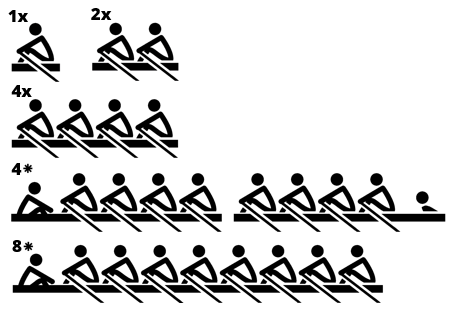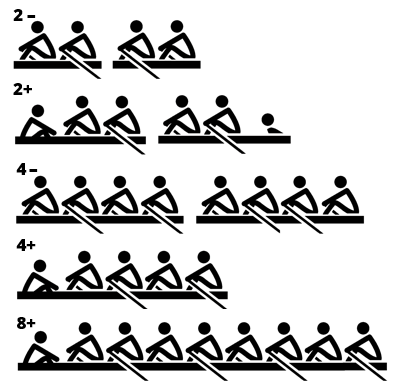|
|
Rowing dictionary – S |
Safe board
Making a safe side ensures that the boat kept stable on one or both side(s) by laying the blades flat on the water and leaning slightly to that side. This safeguards balance.
Saxboard(s)
See:  Gunwale(s).
Gunwale(s).
Scratch crew
A crew which has not rowed with each other before.
Scull
| 1. | An oar made to be used in a sculling boat where each rower has two oars, one per hand. |
| 2. | A boat (shell) that is propelled using sculling oars, e.g., a single scull, is a one-person boat where the rower has two oars. |
Sculler
A rower who rows with two oars, one in each hand.
Sculling
Rowing where each rower has two oars.

Seat
Moulded seat mounted on wheels, single action or double action. Single action is fixed bearing wheel, double action is wheel on axle that rolls on track and rolls on horns of seat.
Seat height
Rigging element that gives the distance between the deepest point at the front of the seat and the water surface. Main article:  Seat height.
Seat height.
Seat number
Seating positions in a racing shell are generally numbered from the bow to the stern in English-speaking countries, unlike many non-English-speaking countries which count from the Stroke forward. Generally the forwardmost rower is called the Bow and the aftmost rower the Stroke, regardless of the number of rowers in the boat, with all other seats simply being numbered. So for instance the crew of an eight (with coxswain) would number off from the bow: Bow, Two, Three, Four, Five, Six, Seven, Stroke, whereas a four (with or without coxswain) or a quad would number off: Bow, Two, Three, Stroke.
Seat race
A method to compare two rowers in fours or eights. Two boats race against each other once. One rower from each boat switch positions, and the two boats race again. Relative performance in the two races is used to compare the abilities of the two rowers.
Seesawing of the blade
Mistake where the blade moves up and down during the draw, often caused by an inconstant pressure during the draw. Main article:  Seesawing of the blade.
Seesawing of the blade.
Set (the boat)
The balance of the boat. Affected by handle heights, rowers leaning, and timing, all of which affect the boat's balance, after which the coxswain tells rowers to "set the boat".
Shell
The smooth hull of the boat. Sometimes made from wood but more commonly now from a synthetic material.
Shooting your slide
When an oarsman's seat moves toward the bow faster than their shoulders. Main article:  Kicking through the seat.
Kicking through the seat.
Shorten the draw
Make a shorter draw. This is often done by rotating the trunk less forward during recovery.
Single scull (1x)
A shell designed for an individual sculler. Very good for skill development, particularly beginners, and a very competitive class at world events, WRC. Extremely rare is the coxed single which is only used as a training boat or for adaptive rowing.
Sitting the boat
Boat in balance by having one or more rowers lay their blades on the water. Main article:  Sitting the boat.
Sitting the boat.
Skeg (or fin)
Thin piece of flat metal or plastic that helps stabilize the shell in the water, and is often positioned so that it protects the rudder.
Skying
Rowing mistake where the oars brought back to the catch too high above the water. Main articles:  Scull skying and
Scull skying and  Sweep skying.
Sweep skying.
Sleeve
A thick piece of plastic around the oar to keep the oarlock from wearing out the shaft of the oar.
Slide length
Rigging element that indicates the distance the seat can move. Main article:  Slide length.
Slide length.
Slide/sliding
Buckle the knees in, so that the seat slides to the stern of the boat.
Sliding stroke
Container mistake in which rower makes several mistakes and which arises (the cause) because rowers learn to row with sliding the blades over the water. Main article:  Sliding stroke.
Sliding stroke.
Sliding too early
Mistake where the rower bends his legs too early at the recovery. Main article:  Sliding too early.
Sliding too early.
Sliding under your shoulders
Mistake where the trunk becomes more vertical during sliding. Main article:  Sliding under your shoulders.
Sliding under your shoulders.
Slings
Folding, portable temporary boat holders. Two are required to hold a boat.
Slouching
Mistake where the rower is not sitting correct in the boat. Main article:  Slouching.
Slouching.
Smoothie
A blade design developed by Concept2 in which the face of the oar blade is smooth, without the traditional central spine. Later designs called Smoothie Vortex, Fat Smoothie.
Spacing / Run
Only applicable for eights. The distance between bowman's puddle on one stroke and the point at which the No. 7 rower catches water on the next stroke.
Span (sculling)
Rigging element for sculling boats: the span is the distance between the center of both oarlock pins. Main article:  Span (sculling).
Span (sculling).
Sparring
An (informal) match between several teams.
Speed coach
A device hat determines the boat's speed based on the speed of a small propeller and shows this information on the coxbox.
Speed tube
Device that is attached to the stern of a single, double or pair and that shows the speed of the boat during the stroke. Main article:  Speed tube.
Speed tube.
Spin turn
Term used to describe turning the boat on its axis.
Spine movement
Mistake where the spine is bend and stretched. Main article:  Spine movement.
Spine movement.
Split time (split)
Amount of time it takes to row 500 meters. Displayed on all ergs and on coxboxes with speed indication. It is roughly between 2:30 and 1:30. Calculator:  Split time.
Split time.
Spoon
See:  Blade.
Blade.
Spread (sweep rowing)
Rigging element that indicates how far the oarlock extends, measured from the center of the boat. Main article:  Spread (sweep rowing).
Spread (sweep rowing).
Sprint
The last 500 meters of most races are generally at a much higher rating than the rest of the race, as crews pull to exhaustion.
Square or squaring
To turn the oar so that the spoon is at 90 degrees (perpendicular) to the water (opposite of feather). This action should be done early during the recovery to ensure good preparation for the catch. Also see:  Feathering.
Feathering.
Squared blade(s), rowing with
Exercise in which the blades should not be turned. Main article:  Squared blade(s).
Squared blade(s).
Squaring too late
Mistake where the rower squares his blade(s) too late. Main article:  Late squaring.
Late squaring.
Stakeboat
An anchored boat or pontoon from which rowing boats are held prior to a race starting.
Standing start
A racing start done from stationary. Also see:  Running start.
Running start.
Starboard (or starboard side)
See:  Bowside.
Bowside.
Starting gate
A structure at the starting line of the race. The shell is “backed” into the starting gate. Once in the gates a mechanism, or a person lying on the starting gate, holds the stern of the shell.
Status
Levels of racing determined by the number of times an rower has won a race. Rowers are awarded points for each race they win. In a crew boat status is determined by the total number of points the crew has.
Stern
The end of the boat that travels through the water last.
Stern pitch oarlock pin
Rigging element that gives the angle (tilting) of the oarlock pin parallel to the boat. Main article:  Stern pitch oarlock pin.
Stern pitch oarlock pin.
Sticky handle(s)
Mistake where the handle(s) pause for a moment at the finish. Main article:  Sticky handle(s).
Sticky handle(s).
Sticky trunk
Mistake where the trunk waits for the arms to be put away. Characteristic of the classic stroke. Main article:  Sticky trunk.
Sticky trunk.
Straight inner arm
Mistake where a sweep rower stretches his inner arm. Main article:  Straight inner arm.
Straight inner arm.
Stretcher
See:  Foot stretcher.
Foot stretcher.
Stroke
One cycle of the oar. Main article:  Stroke
Stroke
Stroke (seat)
The rower closest to the stern of the boat, responsible for the stroke rate and rhythm.
Stroke against crew
Crew exercise to promote similarity and where the stroke varies stroke rate and power and the crew has to follow within a predefined number of strokes. Main article:  Stroke against crew.
Stroke against crew.
Stroke pair
The two rowers closest to the stern of the boat: the stroke and the rower behind him.
Stroke quadrants
The two parts of the draw: from the catch until the oar perpendicular to the boat (1) and from this point to the finish (2). Main article:  Stroke quadrants.
Stroke quadrants.
Stroke rate
The number of strokes executed per minute by a crew. Main article:  Stroke rate.
Stroke rate.
Stroke rate variation
Conditional exercise where the purpose is to increase the stroke and bring more in the comfort zone of a rower. Main article:  Stroke rate variation.
Stroke rate variation.
Strokeside
The left hand (port) side of the boat as the cox sits or the right hand side of the boat for a rower. Often marked by a red marking on the oar.
Sweep rowing
Rowing with one oar on one side of the boat. In a sweep boat, each rower has only one oar.

Swelling stroke
An (obsolete) view of the rowing stroke where the majority of the draw 's power is delivered in the second half. Not to be confused with accelerated draw, compensating for the acceleration of the boat.
Swing
A feeling in the boat when the rowers are driving and finishing their strokes strongly and getting good layback.
Swivel
See:  Oarlock.
Oarlock.
Systematically tapping the water
Mistake where the water is tapped at the same moment during the recovery. Main article:  Systematically tapping the water.
Systematically tapping the water.
 |
Rowing dictionary – R |
 |
Rowing dictionary – T |
This article was translated automatically and is provided to you for free. You are most welcome to improve it!











